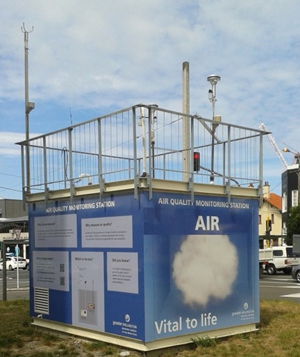There are different instruments available for measuring levels of air pollutants. Regional councils and unitary authorities choose their instruments based on factors such as cost, ease of operation, reliability, accuracy and the smallest time scale of data needed, e.g., 10 mins or 24-hours. There are also monitoring methods (described below) which are required for determining compliance with New Zealand's National Environmental Standards for Air Quality (NES-AQ).
Air quality monitoring stations
Air quality monitoring instruments are usually housed inside a specially designed monitoring station or enclosure, where temperatures are controlled. Outdoor air is drawn inside the housing where it is continuously sampled and analysed by monitoring instruments. An average for the air pollutant is calculated (e.g., every 10 minutes) and transmitted by telemetry (automated data communication) to the council’s or contractor’s air quality database. The raw data is periodically checked and any ‘spikes’ that are caused by instrument servicing and calibrations are removed. Some gaseous pollutants can also be measured by methods such as passive sampling that are relatively inexpensive, simple to operate and typically provide monthly averages that can then be used to calculate an annual average.
Air quality monitoring stations also often include meteorological equipment attached to a mast for measuring air temperature, wind speed, wind direction etc. This meteorological information is useful for interpreting the air pollutant measurements e.g., predicting where sources of pollutants may be coming from and why pollutant concentrations may be changing on an hourly, daily, seasonal or even annual basis.

Inner city Wellington monitoring station
Measuring airborne particles
Airborne particulate matter comes in many shapes and sizes and has varying toxicity. For health reasons monitoring is undertaken for levels of particles that are small enough to be inhaled (PM10) and, in an increasing number of situations, levels of PM2.5 which are even smaller sized particles able to penetrate deep into the lungs and enter the bloodstream.
There are different methods and instrument types that can be used to measure particle concentrations in air. These methods produce different results when compared to each other. Historically particles have been measured using a ‘gravimetric reference method’ such as a high volume sampler. Many of the studies that first linked concentrations of particles in air to adverse health effects in populations were based on PM10 collected by the gravimetric method. As technology advanced it became possible to measure particle concentrations continuously in real time. The United States Environmental Protection Agency (USEPA) has a test method for evaluating how continuous instruments compare with the gravimetric reference method when they are used side-by-side. If the continuous instruments compare well then they are officially recognised as ‘equivalent’ to the gravimetric method. The USEPA updates this list each year.
Some councils have co-located gravimetric reference monitoring instruments with continuous instruments to derive an adjustment factor that can be used to correct the continuous instrument data so it matches what might have been found if the gravimetric method was used.
Examples of continuous instruments that have been approved by the USEPA or the European Union and are used by councils in New Zealand to measure PM10 and/or PM2.5 include: BAM, BAM–nephelometer, TEOM, TEOM-FDMS, Fidas and T640x. Examples of gravimetric instruments that also have approval include the Partisol and High Volume samplers. There are other continuous methods which can be used for investigating air quality, such as an E-BAM or optical sampler, but these are not suitable for NES-AQ compliance monitoring because they don’t have Australian or NZ Standards for operation under schedule 2 of the NES-AQ or are unable to meet the requirements of the Demonstrated Equivalence Standard.
NES-AQ monitoring methods
The NES-AQ lists methods for monitoring PM10, carbon monoxide, nitrogen dioxide, sulphur dioxide and ozone. These are the Australian Standards AS 3580 Methods for sampling and analysis of ambient air that relate to a specific type of instrument and describe how the instrument is to be operated and calibrated. The NES-AQ also allows PM10 to be monitored using instruments that have been certified as USEPA Reference method (e.g. Thermo Partisols, high volume samplers, Met One E-SEQ-FRM), however these only provide 24 hour averages.
Where can I find more information?
- Check with your regional council or unitary authority for more on how they monitor air quality in your region.
